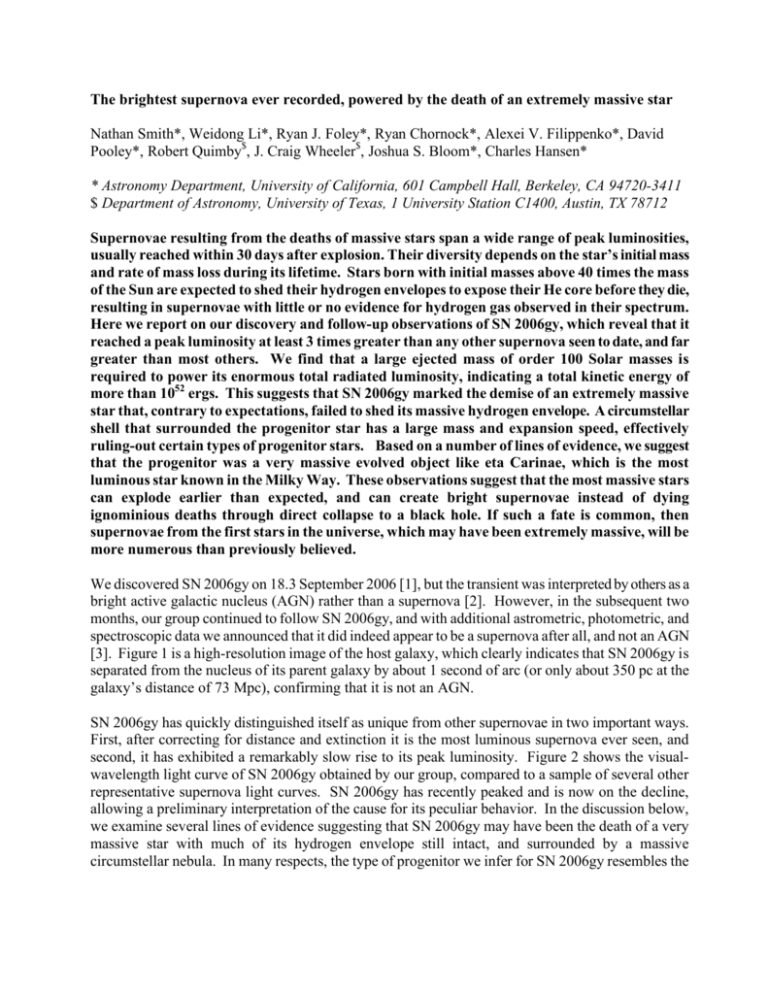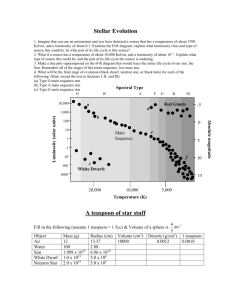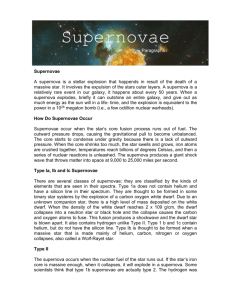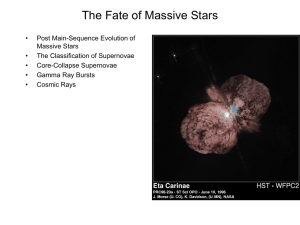The brightest supernova ever recorded, powered by the death of an
advertisement

The brightest supernova ever recorded, powered by the death of an extremely massive star
Nathan Smith*, Weidong Li*, Ryan J. Foley*, Ryan Chornock*, Alexei V. Filippenko*, David
Pooley*, Robert Quimby$, J. Craig Wheeler$, Joshua S. Bloom*, Charles Hansen*
* Astronomy Department, University of California, 601 Campbell Hall, Berkeley, CA 94720-3411
$ Department of Astronomy, University of Texas, 1 University Station C1400, Austin, TX 78712
Supernovae resulting from the deaths of massive stars span a wide range of peak luminosities,
usually reached within 30 days after explosion. Their diversity depends on the star’s initial mass
and rate of mass loss during its lifetime. Stars born with initial masses above 40 times the mass
of the Sun are expected to shed their hydrogen envelopes to expose their He core before they die,
resulting in supernovae with little or no evidence for hydrogen gas observed in their spectrum.
Here we report on our discovery and follow-up observations of SN 2006gy, which reveal that it
reached a peak luminosity at least 3 times greater than any other supernova seen to date, and far
greater than most others. We find that a large ejected mass of order 100 Solar masses is
required to power its enormous total radiated luminosity, indicating a total kinetic energy of
more than 1052 ergs. This suggests that SN 2006gy marked the demise of an extremely massive
star that, contrary to expectations, failed to shed its massive hydrogen envelope. A circumstellar
shell that surrounded the progenitor star has a large mass and expansion speed, effectively
ruling-out certain types of progenitor stars. Based on a number of lines of evidence, we suggest
that the progenitor was a very massive evolved object like eta Carinae, which is the most
luminous star known in the Milky Way. These observations suggest that the most massive stars
can explode earlier than expected, and can create bright supernovae instead of dying
ignominious deaths through direct collapse to a black hole. If such a fate is common, then
supernovae from the first stars in the universe, which may have been extremely massive, will be
more numerous than previously believed.
We discovered SN 2006gy on 18.3 September 2006 [1], but the transient was interpreted by others as a
bright active galactic nucleus (AGN) rather than a supernova [2]. However, in the subsequent two
months, our group continued to follow SN 2006gy, and with additional astrometric, photometric, and
spectroscopic data we announced that it did indeed appear to be a supernova after all, and not an AGN
[3]. Figure 1 is a high-resolution image of the host galaxy, which clearly indicates that SN 2006gy is
separated from the nucleus of its parent galaxy by about 1 second of arc (or only about 350 pc at the
galaxy’s distance of 73 Mpc), confirming that it is not an AGN.
SN 2006gy has quickly distinguished itself as unique from other supernovae in two important ways.
First, after correcting for distance and extinction it is the most luminous supernova ever seen, and
second, it has exhibited a remarkably slow rise to its peak luminosity. Figure 2 shows the visualwavelength light curve of SN 2006gy obtained by our group, compared to a sample of several other
representative supernova light curves. SN 2006gy has recently peaked and is now on the decline,
allowing a preliminary interpretation of the cause for its peculiar behavior. In the discussion below,
we examine several lines of evidence suggesting that SN 2006gy may have been the death of a very
massive star with much of its hydrogen envelope still intact, and surrounded by a massive
circumstellar nebula. In many respects, the type of progenitor we infer for SN 2006gy resembles the
luminous blue variable (LBV) star eta Carinae in our own Galaxy, as discussed below.
SN2006gy was classified as a type IIn supernova exhibiting narrow lines of hydrogen in its spectrum
at early times [4], although the spectrum has notable differences compared with prototypes of this
class. It dramatically violates the expectation that type II supernovae are generally fainter than type I
supernovae (Figure 2 includes a typical type II supernova SN1999em [5]), and that type IIn
supernovae typically show a more rapid rise, taking only about 20 days to reach their peak visual
brightness [6]. SN2006gy, by contrast, took about 70 days to climb to its peak. Also, for at least100
days it remained brighter than –20.5 mag, which is still more luminous than any other supernova.
Interestingly, SN1987A took a similarly long time to reach its peak luminosity [7], but it was 250
times fainter than SN2006gy.
Simply put, for a supernova to be extremely luminous and to remain so for such an extended time is
truly spectacular, and requires a vast reservoir of thermal energy to continually power the observed
radiation. Integrating over the light curve in Figure 2 and adopting no bolometric correction, we
calculate a total radiated energy of Erad = 7×1050 ergs, where the uncertainty is dominated by the
adopted extinction of the host galaxy (see Fig. 2). This is a phenomenal amount of radiated energy,
about 100 times more than that of most type II supernovae. It ultimately comes from the release of
thermal energy contained in the envelope of the star that was ejected. Radioactive decay is not
expected to power the light curve until late times*, and the luminosity from interaction with
circumstellar material probably makes a relatively small contribution, as we discuss later. The initial
gravitational binding energy of the star should equal the initial thermal energy in the envelope, and the
energy deposited by the shock to unbind the star may have contributed as much as half the radiated
energy. Therefore, we divide Erad by a factor of 2 to estimate the contribution from that initial thermal
energy contained in the star’s envelope. This can provide an estimate of the ejected mass from
E rad GM* M ej
"
,
2
R*
!
where M*, Mej, and R* are the stellar mass, ejected mass, and stellar radius at the time of explosion,
respectively. The ejected radiating mass can then be expressed as
Mej ≈ 115 M × (Erad/1051 ergs)1/2 (R*/100 R)1/2 (f)-1/2 ; (f < 1),
where f is the fraction of the total mass ejected in the explosion. We have adopted R*=100 R (7×1012
cm), appropriate for a blue supergiant with a luminosity L=4×106 L (1.6×1040 ergs/s) and an effective
surface temperature Teff=20,000 K, similar to eta Carinae’s present state [8]. This is the smallest
plausible radius for a blue supergiant with a massive hydrogen envelope. Thus, from our measured
value of Erad, we find a likely ejected mass of ~100 M, if we adopt a hypothetical value f≈0.9. The
total mass of the progenitor at the time of explosion would then have been ~110 M. The uncertainty
* One potential caveat would be if SN2006gy was a special type of supernova that may occur in very massive stars in the
early universe, where the star’s Fe/Ni core can be disintegrated by pair-production instability, so that a large mass of
ejected Ni could power the luminosity with radioactive decay. However, even if it is possible, this interpretation would not
alter our essential thesis that the SN2006gy was the explosion of a very massive star.
in this mass could be as high as a factor of 2, but is difficult to quantify because it depends on our
assumptions and the future behavior of the light curve, rather than measurement error. However, our
assumptions were made so as to make the mass estimate conservative. For example, to estimate Erad,
we only included the observed radiation thus far; while SN2006gy is in decline, it remains more
luminous than any other supernova at –21 mag, so the total radiated energy will certainly be higher.
Also, the extinction we adopted may be low. In any case, even allowing for factors of 2, the huge
amount of radiated energy requires that the progenitor of SN2006gy was a very massive star at the
time it exploded. It is likely that its initial mass at birth was near the putative upper limit to stellar
masses of ~150 M [9].
Expansion velocities seen in spectra of the supernova also provide critical clues to its nature. The
spectrum of the broad Hα line in Figure 3 indicates an expansion speed of about 4,000 km/s. If we
adopt the ejecta mass of ~100 M, we find a total kinetic energy of roughly 1.6×1052 ergs. This large
energy is consistent with the idea that SN2006gy was caused by the death of a very massive star.
Based on the lack of significant deceleration since early times, as well as the limit that the observed Xray emission from SN2006gy sets for the progenitor star’s mass-loss rate (see Supplementary
Information), we conclude that interaction with circumstellar material is unlikely to dominate the
radiated luminosity from SN2006gy during its first ~100 days. This is critical for interpretations that
rely on the conversion of kinetic energy to power the observed radiation, as in a scenario where a type
Ia SN explodes within a dense asymptotic giant branch (AGB) star’s wind (sometimes called a type IIa
supernova). Recently, Ofek et al. [10] have advocated this interpretation for SN2006gy, as for the
very bright SNe 2002ic and 2005gj in Figure 2 [11,12]. However, the efficiency of converting kinetic
energy to radiation results in a catch 22. Namely, a very large mass of ejecta and a very large kinetic
energy of order 1052 ergs would be required to contribute significantly to the light curve. While this
would be consistent with the ejecta mass and energy we derive here (motivating our claim of a factor
of ~2 uncertainty in the derived mass), the “type IIa” model requires nearly 100% efficiency for
converting ~1051 ergs of input kinetic energy to power the observed luminosity, where ~1 M of ejecta
sweeps up ~1 M of material. This is unlikely, given that the SN 2006gy expansion speed has not
decelerated much. Thus, we conclude that the radiative energy budget is a severe obstacle to the “type
IIa” interpretation for SN 2006gy.
The high-resolution spectrum in Figure 3 contains a narrow component to the Hα line, which exhibits
a clear P Cygni absorption profile. The supernova is therefore expanding into a hydrogen-rich stellar
wind or circumstellar nebula of the progenitor star, which has an expansion speed of 130-260 km/s.
This expansion speed in the progenitor’s environment is much faster than typical wind speeds of AGB
stars (10-20 km/s), effectively ruling out the interpretation of SN2006gy as a type IIa supernova noted
earlier [10]. This speed is also too fast for a red supergiant wind (20 - 40 km/s), and an order of
magnitude too slow for the wind of an O supergiant or Wolf-Rayet (WR) star progenitor. However,
this speed is consistent with an LBV wind or nebula [8]. The fastest LBV nebula known is the one
around eta Carinae, with a maximum speed of about 650 km/s, but it would show a deep absorption
trough at -150 to -250 km/s were it viewed from intermediate latitudes [13].
At a distance of 73 Mpc, the luminosity of the narrow component of the Hα line in the bottom panel of
Figure 3 would be about LHα≈4.4×105 L. Using this Hα luminosity, and assuming that the line
originates from a circumstellar shell nebula of constant density, the nebular ionized gas mass can be
expressed as
M H" #
!
m H L H"
h$" eff
H" n e
where hν is for an Hα photon, αeffHα=8.64×10-14 cm3 s-1 is the case B Hα recombination coefficient,
and ne is the average electron density. This yields MHα≈11.4 M (LHα/ne). We do not know the
electron density in the nebula around SN 2006gy, but values of 105-106 cm-3 are the highest densities
typically seen in young LBV nebulae like the one around eta Carinae [13,14]. With the observed Hα
luminosity and densities of this order, it is difficult to avoid a nebular mass below 2 M, and it could
easily be as high as 20-30 M. Interestingly, such large numbers would be consistent with the ≥12.5
M nebula around eta Carinae [16]. Lower densities typically seen in circumstellar nebulae around
lower-mass stars would require implausibly high emitting masses to account for the observed
radiation, exceeding their own stellar masses. Thus, the flux of the narrow Hα component that we
observe is only likely to arise in the circumstellar nebula of an extremely massive star.
We suspect that the very slow rise time in the visual light curve of SN2006gy may be due to a
combination of its relatively slow expansion speed and a small radius at the time of explosion.
SN1987A also took a long time to reach its peak luminosity [7], which is generally attributed to its
explosion as a compact blue supergiant instead of as a large red supergiant [15]. A small radius at the
time of explosion would be consistent with the hypothesis that SN2006gy had a very massive
progenitor star, because stars with initial masses above roughly 40 M never develop sufficiently cool
photospheres to become red supergiants. Instead, they are prevented from getting to that point by a
very unstable stage of evolution when they are seen as LBVs [8]. During this brief evolutionary phase,
a massive star might undergo bursts of mass loss when it can shed more than 10 M of material in a
decade [16]. These events are seen in other galaxies as faint type IIn supernovae, or “supernova
impostors” [17]. They may dominate the mass loss of the most massive stars, shedding more total
mass than line-driven winds during the star’s lifetime [18]. Consequently, LBV stars are frequently
surrounded by circumstellar nebulae with masses of order 10 M [18], like the one we infer to exist
around SN2006gy based on the narrow component of the Hα line.
Thus, while detailed modeling of the light curve, spectrum, and continued observations should
definitely be undertaken to improve our estimates of the ejected mass and energy, it appears that all
available observations are broadly consistent with the hypothesis that the progenitor of SN2006gy was
a very massive star that retained a massive hydrogen envelope at the time it exploded. If this
hypothesis of explosion as a massive LBV is correct, it would have important consequences for our
understanding of stellar evolution. It is currently thought that the instability in the LBV phase is
responsible for the mass shedding that marks the transition from the end of H burning to core He
buring, after which a star appears as a He-rich WR star [18,19,20]. The core He burning WR phase
that follows after the massive hydrogen envelope is stripped away is expected to last a few hundred
thousand years before the star reaches even more advanced stages of nuclear burning and finally
explodes [20]. If LBVs explode before reaching the WR phase, though, it means that they could be in
much more advanced stages of nuclear burning than currently predicted by stellar evolution theory.
SN2006gy is not our first hint that LBVs may explode early [21,22,23], but as the brightest supernova
ever recorded, it is perhaps the most extreme case of a massive star’s death.
If the most massive stars can indeed explode before the WR phase, then our current ignorance of the
instability underlying the LBV evolutionary phase presents a critical challenge for stellar evolution.
Namely, SN2006gy may be giving us a clue that the wild instability of the most luminous LBVs like
eta Carinae may be an early warning sign of a massive star’s imminent demise. One implication is that
we had better keep a watchful eye on eta Carinae.
Acknowledgments
This study is based in part on data obtained at the W. M. Keck Observatory, which was made possible
by the generous financial support of the W. M. Keck Foundation. We thank the staffs at the Lick and
Keck Observatories for their assistance. KAIT was made possible by generous donations from Sun
Microsystems, Inc., the Hewlett-Packard Company, AutoScope Corporation, Lick Observatory, the
National Science Foundation, the University of California, and the Sylvia \& Jim Katzman
Foundation. Supernova research at UC Berkeley is supported by NSF grant AST-0607485.We thank
James Graham and Marshall Perrin for assistance with the Lick AO observations and data reduction.
We thank the DEEP team, and especially Michael C. Cooper, for their hard work and assistance with
their DEIMOS reduction pipeline. JCW and RQ are supported in part by NSF Grant AST-0406740.
References
1. Quimby, R., CBET, 644, 1 (2006)
2. Prieto, J.L., Garnavich, P., Chronister, A., & Connick, P., CBET, 648, 1 (2006)
3. Foley, R.J., Li, W., Moore, M., Wong, D.S., Pooley, D., & Filippenko, A.V., CBET, 695, 1 (2006)
4. Harutyunyan, A., Benetti, S., Turatto, M., Cappallero, E., Elias-Rosa, N., & Andreuzzi, G., CBET, 647, 1 (2006)
5. Leonard, D.C., et al., PASP, 114, 35 (2002)
6. Li, W., Filippenko, A.V., Van Dyk, S.D., Hu, J., Qiu, Y., Modjaz, M., & Leonard, D.C., PASP, 114, 403, (2003)
7. Hamuy, M., & Suntzeff, N. B., AJ, 99, 1146 (1990)
8. Humphreys, R.M., & Davidson, K., PASP, 106, 1025 (1994)
9. Figer, D.F., Nature, 434, 192 (2005)
10. Ofek, E.O., et al, ApJL submitted, astro-ph/0612408 (2007)
11. Hamuy, M., et al., Nature, 424, 651 (2003)
12. Aldering, G., et al., in press, astro-ph/0606499 (2006)
13. Smith, N., ApJ, 644, 1151 (2006)
14. Gull, T.R., Vieira, G., Bruhweiler, F., Nielsen, K.E., Verner, E., & Danks, A., ApJ, 620, 442 (2005)
15. Woosley, S.F., Pinto, P.A., & Ensman, L., ApJ, 324, 466 (1988)
16. Smith, N., et al., AJ, 125, 1458 (2003)
17. Van Dyk, S.D., in ASP Conf. Ser. 332, 47 (2005)
18. Smith, N., & Owocki, S.P., ApJ, 645, L45 (2006)
19. Langer, N., Hamann, W.R., Lennon, M., Najarro, F., Pauldrach, A.W.A., & Puls, J., A&A, 290, 819 (1994)
20. Abbot, D.C., & Conti, P.S., ARAA, 25, 113 (1987)
21. Gal-Yam, A., et al., astro-ph/0608029 (2007)
22. Kotak, R., & Vink, J.S. astro-ph/0610095 (2007)
23. Smith, N., AJ, in press, astro-ph/0611544 (2007)
24. Max, C.E., et al., Science, 277, 1649 (1997)
25. Schlegel, D. J., Finkbeiner, D. P., & Davis, M., ApJ, 500, 525 (1998)
26. Richmond, M. W., et al., AJ, 111, 327 (1996)
27. Galama, T. J., et al., Nature, 395, 670 (1998)
28. Benetti, S., Cappellaro, E., Turatto, M., Taubenberger, S., Harutyunyan, A., & Valenti, S., in press, astroph/0611125 (2006)
29. Fransson, C., Lundvist, P., & Chevalier, R.A., ApJ, 461, 993 (1996)
30. Pooley, D., et al., ApJ, 572, 932 (2002)
Supplementary Information
Why interaction with circumstellar material does not power the radiated luminosity of SN2006gy
The expansion speed of 4000 km/s that we observe near peak brightness is critical for addressing the
extent to which interaction with circumstellar material may power the observed radiation, because it
has not changed much from the initial expansion speed of ~4500 km/s seen in the broad P Cygni
absorption of Hβ at only a few days after discovery [4]. If the expanding blast wave has only slowed
by about 10% in the first few months, conservation of momentum dictates that the mass of swept up
material is only about 10% of the ejected mass. This makes it difficult to extract Erad=7×1050 ergs
from a type Ia SN that has a kinetic energy of ~1051 ergs.
Furthermore, the conditions required to explain SN 2006gy as a “type IIa” supernova are
unprecedented. Ofek et al. [10] find that the supernova must expand into the wind of an asymptotic
giant branch (AGB) star that has had a mass-loss rate of 0.01 M/yr for the past 100 yr. Such
powerful winds are not observed in even the most extreme AGB stars, and this enhanced mass-loss
episode from the companion would need to be synchronized with the supernova.
Furthermore, recent observations by the Chandra X-ray Observatory have resolved SN 2006gy in the
soft (0.5-0.8 keV) X-ray band, revealing an X-ray luminosity of about 1.65×1039 erg/s. This constrains
the mass-loss rate of the progenitor star to be less than 10-4 M/yr, as explained in more detail below.
This effectively rules out the interpretation of SN2006gy as a Type Ia SN exploding in a dense AGB
environment, because that model requires a mass-loss rate 100 times higher than what is permitted by
the observed X-ray flux. It seems far more straightforward to invoke the explosion of a very massive
star like eta Carinae.
Using the Chandra X-ray Observatory, we observed SN2006gy at t=57 days after discovery. At the
position of SN2006gy, four counts were detected in an exposure of 29.743 ks with the Advanced CCD
Imaging Spectrometer after correcting for the background flux, which precludes a detailed spectral
analysis. However, the counts were all detected below 1.5 keV, giving some indication of the spectral
shape. We assume a thermal plasma spectrum (Raymond-Smith) with kT = 1 keV to estimate the
luminosity. Such thermal spectra have successfully fit the X-ray spectra of supernovae, and
temperatures much higher than this would result in significant emission detectable by Chandra (which
was not seen). Based on the observed reddening toward 2006gy of E(B-V)=0.74 mag [10], we assume
an X-ray absorbing column of nH=4.1×1021 cm-2. From this absorbed thermal spectral model, we
calculate an intrinsic X-ray luminosity (integrated over photon energies of 0.5 to 2 keV) of 1.65×1039
erg/s for SN 2006gy.
We expect this X-ray emission to have arisen from the interaction of the outgoing shock with the
circumstellar material. This interaction has been explored in detail [29]. We interpret the softness of
the X-ray emission as having a reverse-shock origin, and we use the adiabatic case [29,30], giving
Lrev = 2.0×1035 ζ (n-3)(n-4)2 (T8)-0.24 exp{-0.116/T8} (Mdot6 / vw)2 (V4)-1 (t/10d)-1 ergs/s/keV,
where Lrev is the reverse shock luminosity of 1.65×1039 erg/s, ζ=0.86 for solar abundances, n is the
index of the ejecta density profile ρSN ∝ t-3 (r/t)-n, which we take to be n=7, T8 is the temperature in
units of 108 K, which for 1 keV is 0.116, Mdot6 is the progenitor star’s stellar wind mass-loss rate in
units of 10-6 M/ yr, vw1 is the wind velocity in units of 10 km/s, V4 is the shock velocity in units of
104 km/s, t is the time since explosion, which is 57 days for the Chandra observation. We assume that
the main shock is expanding at the observed speed of 4500 km/s, so that V4=0.45, and it is running
into a pre-existing medium for the progenitor’s wind expanding at ~200 km/s (vw=20) indicated by the
narrow P Cygni absorption component in Figure 3. With the observed soft X-ray luminosity, this
implies a mass-loss rate for the progenitor star of 6.7×10-5 M/yr. This is higher than a typical AGB
star’s wind, but much lower than the 0.01 M/yr required to account for the observed luminosity of
SN2006gy. Interestingly, however, this mass-loss rate that we derive approaches the observed massloss rate of eta Carinae, which is about 10-3 M/yr [8].
FIGURE 1
Fig. 1 – High-resolution false-colour infrared image of SN 2006gy and the nucleus of NGC 1260
showing a clear offset of the supernova from the galaxy center. Images at three wavebands (J central
wavelength 1.2 micron; H central wavelength 1.6 micron; Ks central wavelength 2.2 micron) were
obtained on 4 November 2006 UTC using the Adaptive Optics (AO) system in Laser Guide Star
(LGS) mode [24] on the Shane 3-meter Telescope at Lick Observatory, Mt. Hamilton, California. The
total integration time in each band was 480 sec, accumulated over 8 exposures. The native pixel scale
of the 256×256 Rockwell PICNIC array is 0.076 arcsecond pixel-1; our custom reduction pipeline,
which accounts for the sub-pixel dithering between exposures in a given bandpass, produces final
mosaiced images with a pixel scale of 0.04 arcsec pixel-1. The SN itself was bright enough to use as a
''tip-tilt'' star for the LGS system and produced an effective resolution full-width half-maximum of 200
mas at H-band. The measured offset of the SN from the centroid of the galactic nucleus is 941
milliarcsec (mas) West, 363 mas North, with a 1-σ uncertainty of 10 mas in each direction; this
confirms and improves the earlier offset measurement using the KAIT imaging data of 880 mas West,
140 mas (uncertainty of 80 mas) [3]. On 5 Nov 2006 UTC, we also used the AO-LGS system in
polarimetry mode but found no evidence that the infrared continuum of the SN was polarised above
the 3% level. Note that NGC1260 is an S0/Sa galaxy, so it may have active star formation. We see
extended Hα emission along the slit in some of our spectra (not shown), it is detected by IRAS, and
high resolution images may show a considerable dust lane [10]. Additionally, SN2006gy is only ~350
from the galaxy’s nucleus.
FIGURE 2
Fig. 2 – Comparison of the light curve of SN 2006gy to other SNe. The unfiltered KAIT images for
SN 2006gy were used to derive a R-band light curve for SN 2006gy. Each image is aligned to a deep
pre-SN image, and the contamination of the host galaxy emission is carefully removed by scaling the
images to the same level. The net flux for the SN is then compared to 19 bright stars using calibrations
from the USNO B1 catalog. To put the flux of SN 2006gy on an absolute magnitude scale, we adopt a
distance of 73.1 Mpc (using H0 = 72 km s-1 Mpc-1 and a recession velocity of 5361 km/s) for the host
galaxy NGC 1260. We also adopted a Galactic reddening of AR = 0.43 mag [25] and a host-galaxy
reddening of AR =1.0 mag. Strong Na I D absorption lines are seen in the spectrum of SN 2006gy
which are suggestive of a large host-galaxy extinction; it could be as high as AR =2.5 mag, beyond
which the continuum shape in the spectrum would be too blue for the Rayleigh-Jeans tail of a
supernova photosphere. Thus, our estimate of Erad in the text and the mass we derive from it are
conservative estimates. For instance, Ofek et al. [10] adopt a larger extinction and find a peak that was
~0.5 mag brighter. We also plot the light curves for several other SNe in the R-band whenever
possible. SN 1998dh is a typical Ia. The data were from our unpublished photometry database, and a
typical absolute magnitude of MR = -19.5 mag is assumed. SN 1999em is a typical type II and the
photometry data were adopted from Leonard et al. [5]. SN 1994I is a typical Ic and the photometry
was adopted from Richmond et al. [26]. SN 1987A is a peculiar type II, with a broad light curve but a
low luminosity. The photometry is from Hamuy et al. [7] and we adopt a distance modulus of 18.50
mag to its host galaxy, the LMC. The light curve for SN 1998bw is adopted from Galama et al. [27].
We also plot two similar SNe to SN 2006gy. The data for SN 2002ic is from Hamuy et al. [12], and
the data for SN 2005gj is from Aldering et al. [13]. Both SN 2002ic and SN 2005gj were interpreted
in the context of a type Ia exploding in a massive circumstellar envelope by some groups [12,13].
Benetti et al. [28], however, suggested that SN 2002ic was the collapse of a stripped-envelope,
massive star in a dense medium.
FIGURE 3
Fig. 3 – The spectrum of the Hα line seen in SN2006gy, with the flux normalized to the underlying
continuum level. The spectrum was obtained on 2006 November 24.51 UT using the DEIMOS
spectrograph on the Keck II telescope. Using a customized version of the DEEP data reduction
pipeline, we obtained sky-subtracted, rectified 2-D images, and wavelengths were calibrated with
respect to an internal arc lamp. We corrected for telluric absorption with comparison to the standard
BD+284211. The inset zooms-in on the narrow P Cyg line profile that we believe to be associated
with slower circumstellar ejecta. Velocities are measured relative to this narrow emission component.
The broad component of the line is narrower (FWHM≈2300 km/s) than most type II supernovae [5],
and the profile is clearly asymmetric. The dashed line labeled “symmetric” is the red side of the broad
Hα line reflected to blueshifted velocities. It is clear that there is significant blueshifted Hα absorption
from 0 km/s out to a sharp blue edge at about –4000 km/s. At that point, the blueshifted emission
recovers to the level expected for a symmetric profile and gradually declines to the continuum level at
about –6000 km/s, just as on the red side of the line (which overlaps with He I λ6680). The expansion
speed of about 4000 km/s is similar to the velocity observed at early times [4] (the line wings
extending out to ±6000 may be due to electron scattering). However, it is less than half the speed of
normal type II supernovae of 10,000 km/s [5]. For the same explosion energy as imparted in a typical
supernova, this would imply an ejected mass that is at least 4 times larger, or at least 40 M. This
would imply that a heavy stellar envelope mass-loaded and slowed the supernova shock. A larger total
energy than a normal supernova would allow even larger masses, however (see text). The blueshifted
absorption trough of the narrow component in the bottom panel has a minimum at about –130 km/s
relative to the peak of the narrow emission, and reaches speeds of –260 km/s at its blue edge. Similar
absorption features were seen in lines of He I, Si II, Fe II, Ca II, O I, etc.









